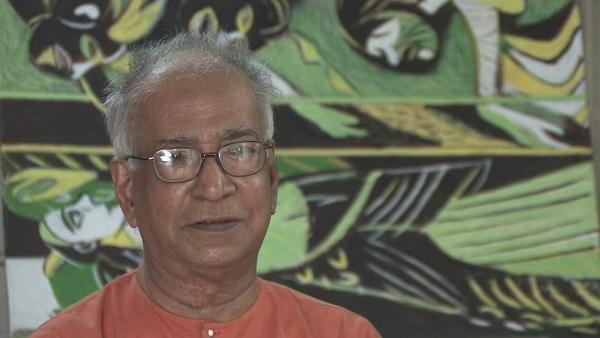NEXT STORY

Santiniketan and Gandhism
RELATED STORIES

NEXT STORY

Santiniketan and Gandhism
RELATED STORIES


|
Views | Duration | |
|---|---|---|---|
| 11. Travelling to Santiniketan and being searched by the police | 62 | 02:20 | |
| 12. Life at Santiniketan and Nandalal Bose | 122 | 03:36 | |
| 13. Santiniketan and Gandhism | 59 | 05:12 | |
| 14. Mohandas Gandhi and art (Part 1) | 67 | 06:54 | |
| 15. Mohandas Gandhi and art (Part 2) | 60 | 06:52 | |
| 16. Gandhi and Nandalal Bose | 75 | 07:30 | |
| 17. Tagore | 64 | 04:47 | |
| 18. Art and religion | 64 | 06:58 | |
| 19. Benode Behari Mukherjee, Brahma and Tulsidas’ monkey god | 84 | 04:47 | |
| 20. Developing relationships with Benode Bihari Mukherjee and... | 60 | 03:14 |


When I went to Santiniketan I was very happy. Partly because I had found out during the time in prison that I was - probably did not have the kind of talents that will sort of keep me or the kind of energy to keep me a political activist. But at the same time, I was terribly impressed by the kind of a cultural generation programme of Rabindranath and the people of the area. So I thought that that was the right place. And then at that time Santiniketan lived up to my expectations. That’s how the whole thing started and when I first went there, luckily, or luckily for me, most of the teachers and students of Kala Bhavan, most of them had gone to I think had probably gone to Bombay with a Tagore play. So the only people there at that time in Santiniketan were Nandalal Bose, Benode Bihari Mukherjee and Ramkinkar Baij. So when I, the first few days I was in their hands really. So I can to know them more intimately than I would have if the whole group was there. And Nandalal, any new entrant he wanted them to paint and show him the work and then he would discuss it, which he did. And he thought I was doing something that was worth noticing and he even took it round to Benode Bihari and Raminkar and showed them. I don’t even remember what kind of trash I showed him. Well at that time, it did put up my spirits. Later, of course, Nandalal was more stringent and then we didn’t always get along together. But then he was very nice; I mean in spite of all the - because Nandalal was a sort of a, he was a sort of a person who had a kind of a conflict with himself. On one hand, he wanted sort of fresh mind to come, this sort of a thing. And the kind of education that you get in the universities is not the kind of thing that leaves your mind fresh. You are already predisposed to a certain way of thinking. So he suspected people who had a background of education. But then on the other hand he was very liberal, I mean he was always nice. So even in those days when he didn’t think I was going according to the sort of laid out sort of a programme, he was terribly nice to me. Almost parental in his solicitude, very nice. I still remember that. And then I later also I found out whatever you might say, he had laid the foundations of a different kind of art educational system at Santiniketan. And which is, I think, if anybody followed it, it is as liberal as anything anywhere in the world.
KG Subramanyan (1924-2016) was an Indian artist. A graduate of the renowned art college of Kala Bhavana in Santiniketan, Subramanyan was both a theoretician and an art historian whose writings formed the basis for the study of contemporary Indian art. His own work, which broke down the barrier between artist and artisan, was executed in a wide range of media and drew upon myth and tradition for its inspiration.
Title: Life at Santiniketan and Nandalal Bose
Listeners: Timothy Hyman
Timothy Hyman is a graduate of Slade School of Fine Art, London, in which he has also taught. In 1980 and 1982, he was Visiting Professor in Baroda, India. Timothy Hyman has curated many significant art exhibitions and has published articles and monographs on both European and Indian artists.
Duration: 3 minutes, 37 seconds
Date story recorded: 2008
Date story went live: 10 September 2010